Japan
Wood Products Prices
Dollar Exchange Rates of 10th
Feb
2023
Japan Yen 149.18
Reports From Japan
Investment
in real estate at a five-year low
Uncertainty on when interest rates will change is
discouraging foreign funds and businesses from investing
in the real estate sector such that total investment was at a
five-year low in 2023. Foreign investment in Japanese real
estate fell around 30% to US$6.7 billion in 2023.
Investors worry that, once interest rates start rising,
borrowing costs will increase and squeeze returns on
property investments. With Japan's real estate market seen
nearing its peak, investors are now moving to lock in
profits.
See:
https://asia.nikkei.com/Business/Markets/Property/Japan-real-estate-loses-shine-with-foreign-investors
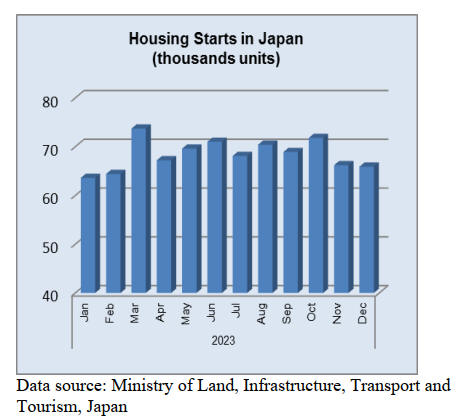
Tokyo Metropolitan Government-sponsored Wood
City
Wooden buildings are being built across Tokyo as
investment grows in high-tech construction timbers to
replace steel and concrete-based mid-rise and high-rise
buildings. Examples can be found in the AEAJ Green
Terrace, which was awarded the ‘Grand Prize’ in the
Tokyo Metropolitan Government-sponsored Wood City
Tokyo Model Architecture Awards.
AEAJ Green Terrace was designed by Kengo Kuma who
also designed Japan’s 2020 Olympic stadium. The Green
Terrace is 3-storey hybrid building.
According to Kuma, the complex timber structure made
from cedar and cypress “reflects the very essence of the
building’s mission – promoting well-being through the
power of aromas”.
See:
https://www.designboom.com/architecture/kengo-kuma-aeaj-green-terrace-tokyo-japan-02-08-2024/
Sharp drop in ‘real’ wages
Ministry of Internal Affairs data show household spending
in Japan fell in 2023 for the first time in three years.
Families cut back on food purchases in the year as
inflation drove up prices from 2022.
Japan's real wages dropped 2.5% in 2023, the second
straight year of decline as salary increases failed to keep
up with inflation. The decrease in real wages, the sharpest
since a 2.8% decline in 2014 when the country's
consumption tax was raised to 8% from 5%, came despite
repeated calls by the Prime Minister for wage increases.
The continued drop in real wages came even after major
Japanese companies raised wages by 4% on average last
year, the biggest increase in 31 years, indicating the move
has not spread to smaller enterprises, which hire nearly
70% of workers.
See:
https://www.investing.com/analysis/japanese-yen-extends-losses-spending-and-income-next-200645799
and
https://www3.nhk.or.jp/nhkworld/en/news/20240206_16/
Four straight months of rise in consumer confidence
index
Japan's consumer confidence improved in January for the
fourth straight month, hitting its highest level in over two
years as high consumer prices began to steadily ease. The
index indicates consumers' economic expectations for the
next six months with a reading below 50 suggesting that
pessimists outnumber optimists.
In light of the trend in consumer confidence the Cabinet
Office upgraded its assessment of sentiment saying
consumer confidence is "improving. In December, it said
it continues “to pick up”.
Among the survey's four components, consumers'
assessment of livelihoods grew to 36.5 following a 1.6
point rise in December, while their readiness to buy new
durable goods increased 1.4 points to 32.8 from the
previous month. However, both indices are below 50.
See:
https://mainichi.jp/english/articles/20240131/p2g/00m/0bu/046000c
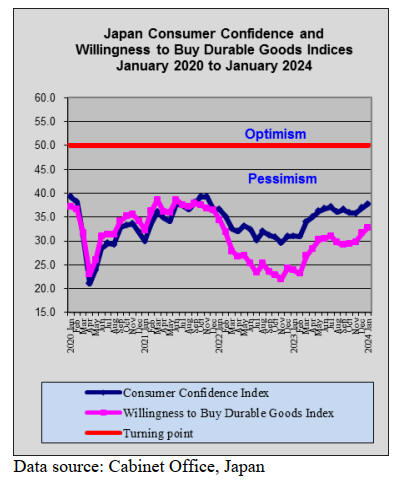
Price increases lift profits for big companies
The domestic press has reported net profits for listed
Japanese manufacturers grew more than 20% year on year
between April and December last year mainly on the back
of price increases and strong auto and machinery sales,
especially to the US. Of the 285 listed companies, 52%
increased profits, up from 47% in the same period of 2022.
Net profits grew at 56% of food makers, 21% in non-
ferrous metals and 3% in electrical machinery.
The average exchange rate during the period was about
143 yen to the dollar, a depreciation of around 7 yen,
which also contributed to improved yen incomes but price
increases were a major factor. On the flip side, companies
with significant sales to China are struggling as investment
and consumer spending is falling.
See:
https://twitter.com/NikkeiAsia/status/1756827754043949099
Hints of action to stem fall in yen exchange
rate
Japan's Masato Kanda, Vice Minister of Finance for
International Affairs said appropriate action will be taken
on the exchange rate if the authorities see the fall in the
yen will undermine the economy.
He added "recent currency moves are rapid. The yen has
weakened by nearly 10 yen over the period of one month
or so and such a rapid move is not good for the economy,".
See:
https://asia.nikkei.com/Business/Markets/Currencies/Japan-will-take-appropriate-actions-on-forex-if-needed-Kanda-says
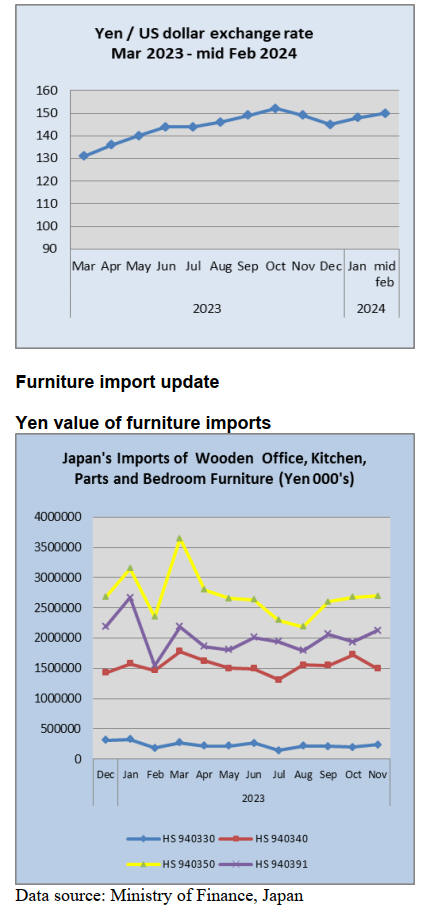
November wooden office furniture imports (HS
940330)
China remained the top supplier of wooden office
furniture in November followed by the US which tilted
shipments from Vietnam into third place. The value of
shipments from China recovered from the slight drop
recorded in October with November shipments accounting
for around 78% of all wooden office furniture imports in
the month.
Malaysia and Indonesia were the two other main
shippers
in November and accounted for 2-3% of monthly imports.
Year on year, the value of November imports of wooden
office furniture was down 28% marking the third straight
year on year decline, however, compared to October there
was an over 20% rise in the value of November imports.
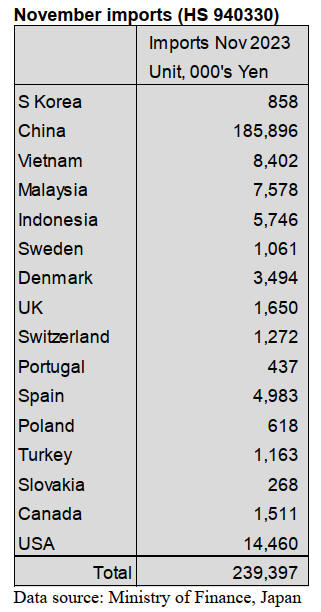
November kitchen furniture imports (HS 940340)
In November there was a year on year drop of around 14%
in the value of wooden kitchen furniture, there was also a
similar decline in the value of imports compared to
October, the first dip in imports since July.

As in previous months shippers in the Philippines
(45% of
total imports) and Vietnam (35% of total imports) together
accounted for most of Japan’s imports of wooden kitchen
furniture.
In November the top three shippers were the Philippines,
Vietnam and China (8% of total imports). Of the other
shipper,s Germany and Italy topped the list.
November wooden bedroom furniture imports
(HS 940350)
After the steady decline in the value of wooden bedroom
furniture in the first half of 2023, beginning in September
there was a sharp recovery and the upward trend continued
with November imports trending slightly higher than in
October and around the same level as in November 2022.
In November, China and Vietnam, once again, secured
their spot as the first and second ranked shipper in terms of
the value of imports. Shipments from China, at 63% of
total imports values, were up compared to October but, at
28% of the total value of November arrivals, shipments
from Vietnam were down.
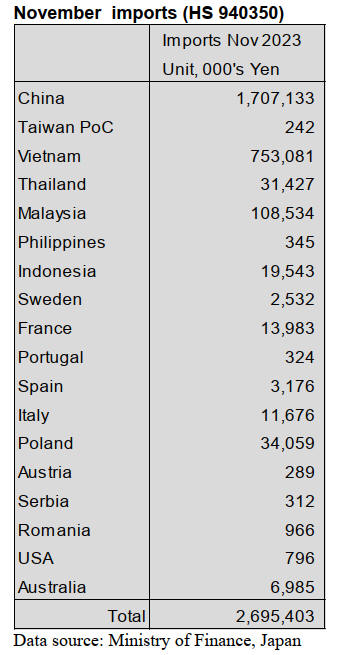
November wooden furniture parts imports (HS 940391)
The sources of wooden furniture parts are very diverse,
more so than with imports of assembled furniture. In
November shippers in China accounted for 45% of the
value of Japan’s wooden furniture parts imports followed
by Indonesia at 20% and Malaysia and Vietnam at around
12% each.
Since mid 2023 there has been a slight upward trend
in the
value of wooden parts imports. While year on year the
value of imports has not moved compared to a month
earlier November imports were up around 10% and this
builds on the gains seen in the previous few months.
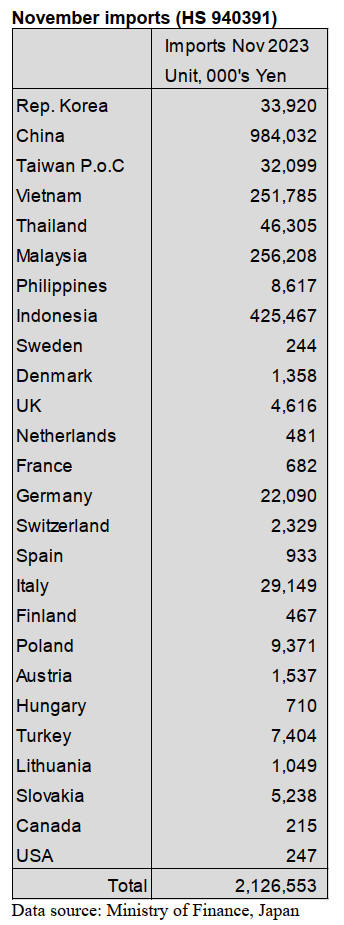
Trade news from the Japan Lumber Reports (JLR)
The Japan Lumber Reports (JLR), a subscription trade
journal published every two weeks in English, is
generously allowing the ITTO Tropical Timber Market
Report to reproduce news on the Japanese market
precisely as it appears in the JLR.
For the JLR report please see:
https://jfpj.jp/japan_lumber_reports/
Volume of composite wood flooring in 2023
According to Japan Acoustic & Laminated Flooring
Manufacturers Association, the product and the sales
amount of composite wood flooring in 2023 decrease from
2022. The product is 17,824,000 tsubo, 8.8 % down from
the previous year.
Shipment is 18,332,000 tsubo, 5.9 % down from the
previous year. For surface dressed lumber, a ratio of sheet
is 76 %, 1 point up from last year.
The produce and the sales amount of composite wood
flooring decrease as the new starts decrease. Also, the
price of a house increased so one-story house was more
popular than a house. Monthly product of composite wood
flooring does not exceed the result of every month last
year. Monthly sales amount of composite wood flooring
exceeds only March, 2023.
The product of OEM exceeds the previous year’s result.
The product of MDF and imported plywood is around the
previous year’s level. The sales amount of MDF and
domestic plywood occupies 40 % of the total sales amount
of 2023 but this is 2 points less than 2022.
On the other hand, the sales amount of MDF and imported
plywood occupies 26 % of the total sales amount of 2023
and this is 2 points up from 2022. The price of hardwood
lumber has been increasing in the world and the weak yen
influences the purchase price.
The sales amount of soundproof floor LL45 occupies 80 %
of the total sales amount of 2023. The sales amount of
soundproof floor LL40 is 95,000 tsubo, 3.6 % down from
the previous year. LL45 is 1,967,000 tsubo, 2.1 % up from
the previous year. LL50 is 17,000 tsubo, 10.3 % more than
the previous year. Soundproof floor for non-housing
buildings is 76,000 tsubo, 28.6 % less than 2022
100 % cypress plywood
Japan Kenzai Co., Ltd. in Tokyo Prefecture and Nisshin
Co., Ltd. in Tottori Prefecture had developed 4 mm
cypress plywood together. All layers of this 4 mm cypress
plywood are cypress layers. They started selling this new
cypress plywood at 98 business offices in Japan as of
February, 2024.
The new cypress plywood is able to be used for interiors
and foundations. The size cypress plywood is 4 mm 3 x 6.
The cypress plywood has 3 layers. The quality of 4 mm
cypress plywood is as same quality as imported plywood.
The new plywood is able to be used for padded floors.
The companies accept small lot orders. Usually, the 4 mm
imported plywood is sold by 350 sheets as a pack but the
companies sell 140 sheets as a pack.
Japan Kenzai and Nisshin had developed 5.5 mm plywood
together in 2021 and there had been a lot of demand for
4.4 mm plywood so they started developing 4.4 mm
plywood. The new cypress plywood is an eco-friendly
product. Also, carbon stocks will be printed on bills.
The companies will promote on using more domestic
lumber and will expect to contribute circular forest and
regions.Since the foreign exchange is unstable, it is hard to
estimate the costs. Purchasing domestic plywood instead
of imported plywood will reduce risks of costs.
Orders for house builders
New orders for house builders in Decembe, 2023 exceed
December 2022’s result. Ther reasons are that the selling
price of houses had increased and there is more orders for
non-housing buildings than houses. A number of custom-
built houses is low. Orders for unit built for sale,
apartment buildings and renovation of a house are firm.
Some house builders feel that the orders for houses are not
recovered yet. On the other hand, another house builder
had good results because they held housing events in last
autumn. Also, the house builders explained to customers
that the Japanese government increased the budget of 2024
for purchasing houses. However, the customers still
hesitate to purchase houses. There is a possibility that the
custom-built housing market will be a tough situation in
2024.
The results of unit built for sale at many house builders
exceed custom-build houses in December, 2023 and the
results in December, 2022. Many house builders will keep
strengthen their unit built for sale business.
The house builders promote saving energy and high-
performance of apartment buildings and the price of
apartment buildings has raised.
Energy-efficiency renovations, which reduce utility
expenses, are popular than renovations of exteriors.
However, there will be a support for renovations of
exteriors from the Japanese government so major house
builders will strengthen in recommending renovations of
exteriors to the customers.
Projection wood product of imports
The Japan Lumber Importers Association disclosed
projection of imported wood products for the first half of
2024. Volume of logs will decrease as same as the first
half of 2023. Volume of lumber will rise.
Total volume of logs and lumber will be 10 % more than
the first half of 2023. However, volume of logs will
decrease by 6 % and volume of lumber will rise by nearly
20 %.
Volume of North American logs and NZ logs will occupy
97 % of the total volume.
Consumption of Douglas fir logs at Chugoku Lumber Co.,
Ltd. will be 30 % lower than before due to the fire
occurred at one of Chugoku Lumber’s plants in August,
2023. This situation would influence the volume of
Doulgas fir logs in the first half of 2024.
Japanese lumber companies would use cedar logs instead
of NZ logs because the price of NZ logs for China had
increased and then also the price had increased for Japan.
Volume of South Sea logs will be limited because supply
environment in South Asia is not good and also
consumption of South Sea logs in Japan is small.
Volume of lumber will increase because it was very
small
volume in the first half of 2023. The reason is that
Japanese importers did not purchase a lot of imported
lumber due to the end of the woodshcok. European lumber
will be 35 % up.
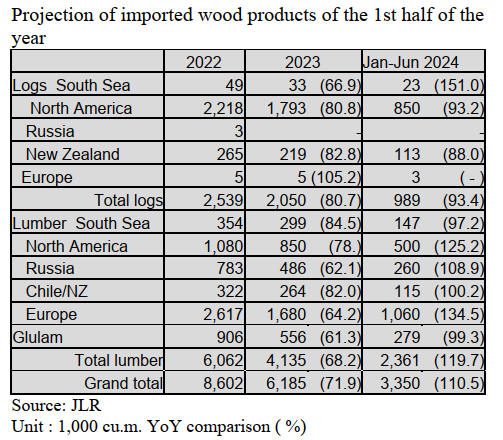
|